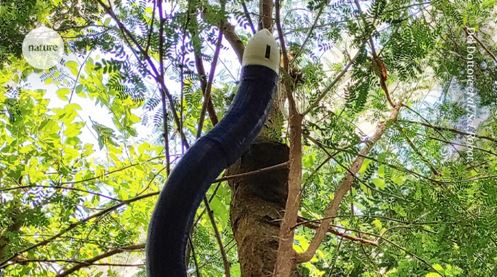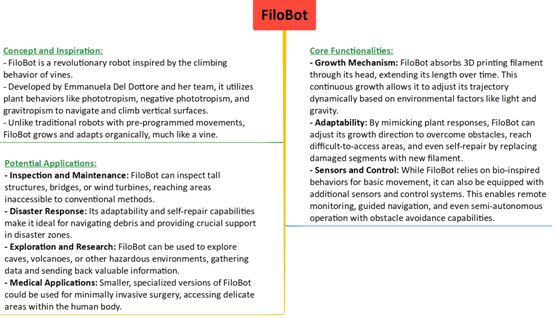Description

Copyright infringement not intended
Picture Courtesy: www.nature.com
Context: The FiloBot, a plant-inspired robot that mimics the climbing behaviour of vines, represents a noteworthy innovation in robotics
Key features and aspects of FiloBot:
Inspiration from Nature
- FiloBot draws inspiration from plant behaviours, including phototropism (movement in response to light), negative phototropism (movement away from light), and gravitropism (response to gravity).
Purpose
- Developed by Emmanuela Dle Dottore and her team, FiloBot is designed to climb structures, mimicking the growth patterns of climbing vines.
- The purpose is to create a robot that can navigate unstructured and dynamic environments with adaptability and responsiveness.
Mechanism
- Unlike traditional climbing robots, FiloBot doesn't rely on pre-programmed movements.
- It absorbs 3D printing filament through its head, extending its length over time, similar to the way a creeper grows.
Adaptability and Responsiveness
- FiloBot has showcased remarkable adaptability by dynamically adjusting its growth trajectory in response to changing light intensity.
- This feature allows it to respond to environmental stimuli in real time.
Autonomous Systems with Additive Manufacturing
- The integration of transportable additive manufacturing techniques with bioinspired behavioural strategies is highlighted.
- This combination allows for the development of future robots that can navigate and even construct infrastructure in challenging environments.

Medical Robotics: Snake-Like Robots
- Jessica Burgner-Kahrs and her team at the University of Toronto Mississauga have been working on snake-like robots for medical surgeries.
- These robots are designed to be slender, flexible, and capable of reaching difficult-to-access areas within the human body.
Medical Advancements
- The snake-like robots offer significant advancements in medical procedures, especially in cases where traditional surgery might be challenging.
- They can navigate intricate paths around vital tissues, potentially making previously inoperable cases feasible.
Transformative Impact
- Burgner-Kahrs emphasizes the transformative impact of these robots, stating that previously inoperable brain tumours might become operable.
- The development extends to semi-autonomous models, which, guided by surgeons, could use sensors to avoid obstacles, enhancing precision and safety.
NASA's Snake-Like Robot
- NASA's Jet Propulsion Laboratory has developed a snake-like robot named EELS 1.0.
- EELS 1.0 is crafted to work on rough terrains of planets and moons within our solar system.
- EELS 1.0 is engineered to navigate diverse landscapes, including ice, sand, cliff walls, deep craters, and lava tubes. This versatility makes it suitable for planetary exploration.
Significance of Nature-Inspired Robotics
- The snake-like robots developed for medical and planetary exploration purposes showcase the significance of drawing inspiration from nature in robotics. These innovations bring about versatile, flexible, and adaptable robotic systems.

Conclusion
- FiloBot and related advancements in snake-like robots represent a merging of technology and inspiration from nature. These innovations have the potential to redefine the capabilities of robots, making them more adaptable, responsive, and versatile in various applications, from navigating complex terrains on Earth to exploring distant planets in our solar system
|
PRACTICE QUESTION
Q. What is FiloBot, recently in the news?
A) A new species of climbing plant discovered in the Himalayas.
B) An innovative plant-inspired robot that climbs structures like vines.
C) A type of bioengineered filament for 3D printing.
D) A mobile application for plant identification.
Answer: B
Explanation:
FiloBot is an innovative plant-inspired robot that mimics climbing vines. This technology has been in the news due to its unique approach to robotics, drawing inspiration from natural plant behaviours for adaptability and responsiveness.
|















